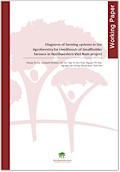| Working Paper Series |
 |
|
| Title | Diagnosis of farming systems in the Agroforestry for Livelihoods of Smallholder farmers in Northwestern Viet Nam project | | Author | Hoang Thi Lua, Elisabeth Simelton, Ha Van Tiep, Vu Duc Toan, Nguyen Thi Hoa, Nguyen Van Chung and Phung Quoc Tuan Anh | | Year | 2013 | | Publisher | World Agroforestry Centre (ICRAF) - Vietnam | | City of Publication | Hanoi, Vietnam | | Series Number | Working paper no. 161 | | Number of Pages | 24 | | Call Number | WP0169-13 | | Keywords | Farming system diagnosis, monocropping, agroforestry, Northwest Vietham, farmers’
adoption |
|
| Abstract: |
| The ‘Agroforestry for Livelihoods of Smallholder farmers in Northwestern Viet Nam’ project (2011–
2016) focuses on agroforestry trials on farms in the northwestern mountainous region of the country.
The objective of the study was to make an inventory of the current upland farming systems and
identify key strengths and weaknesses of each system, including economic efficiency. The farming
system diagnosis was based on participatory assessments and focus group discussions and in-depth
interviews with 45 project ‘farmer co-operators’ in 17 villages in Yen Bai, Son La and Dien Bien
provinces. The study covered three agro-ecozones and four ethnic groups: < 600 masl, generally
populated by Kinh (two villages); 600–800 masl, dominated by Thai (six villages) and > 800 masl,
including H’mong and Kho Mu (nine villages). The economic assessment accounts for annual inputs
and labor costs. To our knowledge, there was no previous systematic study at this scale. The inventory
identified over 20 different farming systems. However, regardless of agro-ecozones and ethnicity, the
predominant land-use on upland slopes was mono-cultivation of staple crops. Over 90% of the farmer
co-operators grew maize, which was also the main source of income for 82%. The estimated
economic profit of this system ranged from below VND 1 million to 12.5 million per hectare per year.
The main drawback of this system was declining soil fertility and yields. In addition, upland farmers’
profits were generally low, ranging from VND 2.4 million (maize) through VND 20 million (cassava
with shan tea) to VND 26 million (tomato) per hectare per year. Profits were lower at higher
elevations. This was because 1) in response to declining soil fertility, increased amounts of fertilizers
were applied but the productivity failed to compensate for increasing production costs; 2) local
varieties of hill rice and maize seem to have degenerated; 3) farmers sold unprocessed grains and
tubers at low, and volatile, prices because their market access and storage capacity was limited; and 4)
the estimated labour costs in this study might be overestimated for distant fields. Farmers, therefore,
wanted to find alternative farming systems, however, few were aware of appropriate tree-based
conservation farming practices. Certain types of agroforestry existed on a small scale, for example,
home gardens with fruit trees or coffee with timber trees or fruit trees as shade (in Son La), cassava
intercropped with shan tea (in Yen Bai), cardamom under forest canopy (in Dien Bien). This study
identified several potential agroforestry models, for example, a combination of staple crops for shortterm
income, grass strips for protection from soil erosion and feed, and trees for medium-to-longerterm
income. The findings of the study will help identify agroforestry systems with potential for wider adoption and will lay the groundwork for the design or redesign of effective agroforestry research in
the region. |
|